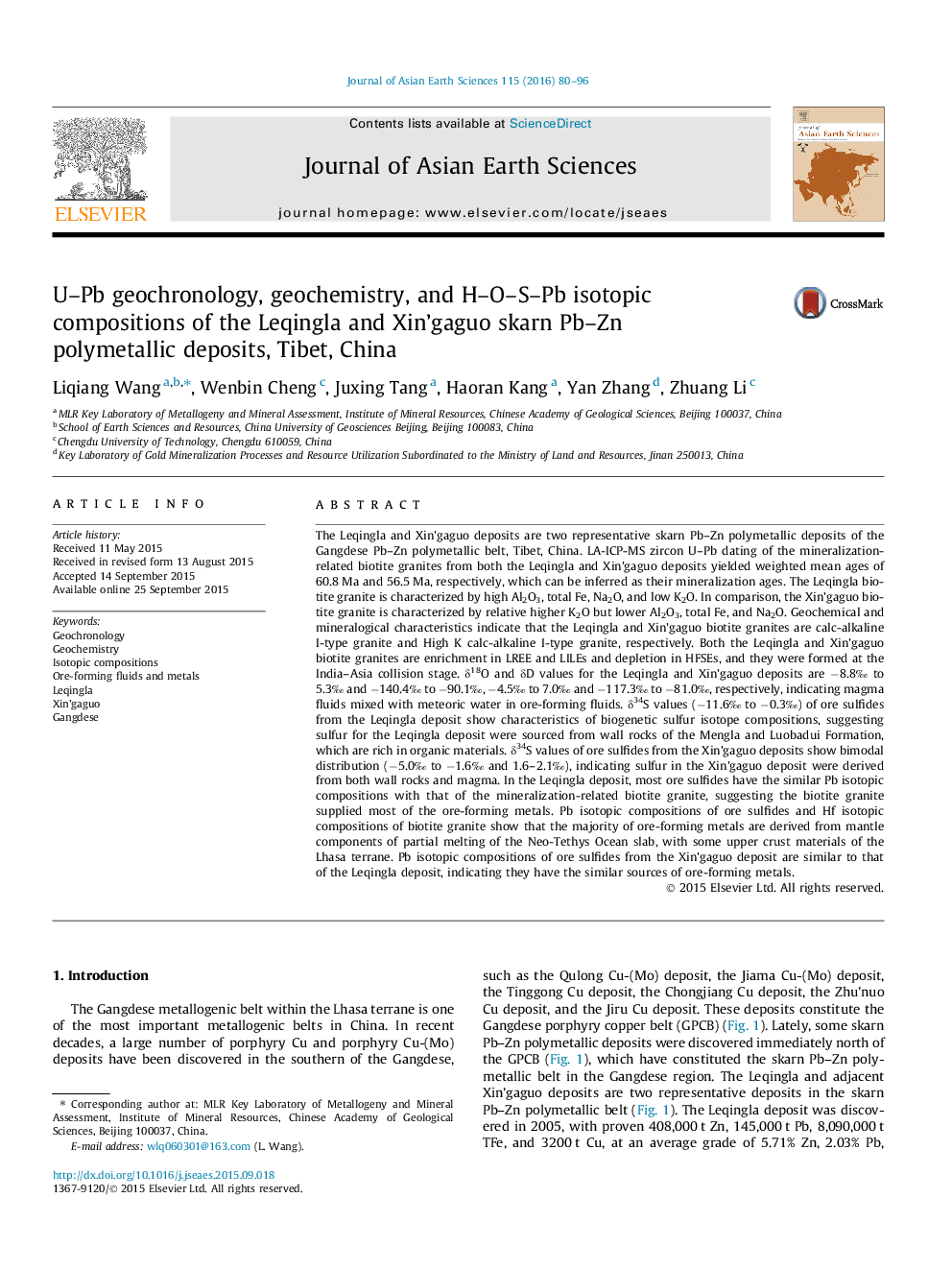| کد مقاله | کد نشریه | سال انتشار | مقاله انگلیسی | نسخه تمام متن |
|---|---|---|---|---|
| 6443968 | 1640356 | 2016 | 17 صفحه PDF | دانلود رایگان |
عنوان انگلیسی مقاله ISI
U-Pb geochronology, geochemistry, and H-O-S-Pb isotopic compositions of the Leqingla and Xin'gaguo skarn Pb-Zn polymetallic deposits, Tibet, China
دانلود مقاله + سفارش ترجمه
دانلود مقاله ISI انگلیسی
رایگان برای ایرانیان
کلمات کلیدی
موضوعات مرتبط
مهندسی و علوم پایه
علوم زمین و سیارات
زمین شناسی
پیش نمایش صفحه اول مقاله

چکیده انگلیسی
The Leqingla and Xin'gaguo deposits are two representative skarn Pb-Zn polymetallic deposits of the Gangdese Pb-Zn polymetallic belt, Tibet, China. LA-ICP-MS zircon U-Pb dating of the mineralization-related biotite granites from both the Leqingla and Xin'gaguo deposits yielded weighted mean ages of 60.8 Ma and 56.5 Ma, respectively, which can be inferred as their mineralization ages. The Leqingla biotite granite is characterized by high Al2O3, total Fe, Na2O, and low K2O. In comparison, the Xin'gaguo biotite granite is characterized by relative higher K2O but lower Al2O3, total Fe, and Na2O. Geochemical and mineralogical characteristics indicate that the Leqingla and Xin'gaguo biotite granites are calc-alkaline I-type granite and High K calc-alkaline I-type granite, respectively. Both the Leqingla and Xin'gaguo biotite granites are enrichment in LREE and LILEs and depletion in HFSEs, and they were formed at the India-Asia collision stage. δ18O and δD values for the Leqingla and Xin'gaguo deposits are â8.8â° to 5.3â° and â140.4â° to â90.1â°, â4.5â° to 7.0â° and â117.3â° to â81.0â°, respectively, indicating magma fluids mixed with meteoric water in ore-forming fluids. δ34S values (â11.6â° to â0.3â°) of ore sulfides from the Leqingla deposit show characteristics of biogenetic sulfur isotope compositions, suggesting sulfur for the Leqingla deposit were sourced from wall rocks of the Mengla and Luobadui Formation, which are rich in organic materials. δ34S values of ore sulfides from the Xin'gaguo deposits show bimodal distribution (â5.0â° to â1.6â° and 1.6-2.1â°), indicating sulfur in the Xin'gaguo deposit were derived from both wall rocks and magma. In the Leqingla deposit, most ore sulfides have the similar Pb isotopic compositions with that of the mineralization-related biotite granite, suggesting the biotite granite supplied most of the ore-forming metals. Pb isotopic compositions of ore sulfides and Hf isotopic compositions of biotite granite show that the majority of ore-forming metals are derived from mantle components of partial melting of the Neo-Tethys Ocean slab, with some upper crust materials of the Lhasa terrane. Pb isotopic compositions of ore sulfides from the Xin'gaguo deposit are similar to that of the Leqingla deposit, indicating they have the similar sources of ore-forming metals.
ناشر
Database: Elsevier - ScienceDirect (ساینس دایرکت)
Journal: Journal of Asian Earth Sciences - Volume 115, 1 January 2016, Pages 80-96
Journal: Journal of Asian Earth Sciences - Volume 115, 1 January 2016, Pages 80-96
نویسندگان
Liqiang Wang, Wenbin Cheng, Juxing Tang, Haoran Kang, Yan Zhang, Zhuang Li,